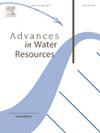Tackling water table depth modeling via machine learning: From proxy observations to verifiability
IF 4
2区 环境科学与生态学
Q1 WATER RESOURCES
引用次数: 0
Abstract
Spatial patterns of water table depth (WTD) play a crucial role in shaping ecological resilience, hydrological connectivity, and human-centric systems. Generally, a large-scale (e.g., continental or global) continuous map of static WTD can be simulated using either physically-based (PB) or machine learning-based (ML) models. We construct three fine-resolution (500 m) ML simulations of WTD, using the XGBoost algorithm and more than 20 million real and proxy observations of WTD, across the United States and Canada. The three ML models were constrained using known physical relations between WTD’s drivers and WTD and were trained by sequentially adding real and proxy observations of WTD. Through an extensive (pixel-by-pixel) evaluation across the study region and within ten major ecoregions of North America, we demonstrate that our models (corr = 0.6-0.75) can more accurately predict unseen real and proxy observations of WTD compared to two available PB simulations of WTD (corr = 0.21-0.40). However, we still argue that currently-available large-scale simulations of static WTD could be uncertain within data-scarce regions such as steep mountainous regions. We reason that biased observational data mainly collected from low-elevation floodplains and the over-flexibility of available models can negatively affect the verifiability of large-scale simulations of WTD. Ultimately, we thoroughly discuss future directions that may help hydrogeologists decide how to improve machine learning-based WTD estimations. In particular, we advocate for the use of proxy satellite data, the incorporation of physical laws, the implementation of better model verification standards, the development of novel globally-available emergent indices, and the collection of more reliable observations.
通过机器学习解决地下水位建模:从代理观察到可验证性
地下水位深度(WTD)的空间模式在塑造生态恢复力、水文连通性和以人为本的系统方面发挥着至关重要的作用。通常,可以使用基于物理的(PB)或基于机器学习的(ML)模型来模拟静态WTD的大规模(例如,大陆或全球)连续图。我们使用XGBoost算法和美国和加拿大的2000多万个WTD真实和代理观测值,构建了三个WTD的精细分辨率(500米)ML模拟。这三个ML模型使用WTD驱动程序和WTD之间的已知物理关系进行约束,并通过顺序添加WTD的真实和代理观测值进行训练。通过在整个研究区域和北美十个主要生态区内进行广泛的(逐像素)评估,我们证明,与两个可用的WTD PB模拟(corr=0.21-0.40)相比,我们的模型(corr=0.6-0.75)可以更准确地预测WTD的看不见的真实和代理观测值。然而,我们仍然认为,在陡峭山区等数据稀缺的地区,目前可用的静态WTD的大规模模拟可能是不确定的。我们认为,主要从低海拔洪泛区收集的有偏见的观测数据和现有模型的过度灵活性会对WTD大规模模拟的可验证性产生负面影响。最后,我们彻底讨论了未来的方向,这可能有助于水文地质学家决定如何改进基于机器学习的WTD估计。特别是,我们主张使用代理卫星数据,纳入物理定律,实施更好的模型验证标准,开发新的全球可用的紧急指数,以及收集更可靠的观测数据。
本文章由计算机程序翻译,如有差异,请以英文原文为准。
求助全文
约1分钟内获得全文
求助全文
来源期刊

Advances in Water Resources
环境科学-水资源
CiteScore
9.40
自引率
6.40%
发文量
171
审稿时长
36 days
期刊介绍:
Advances in Water Resources provides a forum for the presentation of fundamental scientific advances in the understanding of water resources systems. The scope of Advances in Water Resources includes any combination of theoretical, computational, and experimental approaches used to advance fundamental understanding of surface or subsurface water resources systems or the interaction of these systems with the atmosphere, geosphere, biosphere, and human societies. Manuscripts involving case studies that do not attempt to reach broader conclusions, research on engineering design, applied hydraulics, or water quality and treatment, as well as applications of existing knowledge that do not advance fundamental understanding of hydrological processes, are not appropriate for Advances in Water Resources.
Examples of appropriate topical areas that will be considered include the following:
• Surface and subsurface hydrology
• Hydrometeorology
• Environmental fluid dynamics
• Ecohydrology and ecohydrodynamics
• Multiphase transport phenomena in porous media
• Fluid flow and species transport and reaction processes
 求助内容:
求助内容: 应助结果提醒方式:
应助结果提醒方式:


